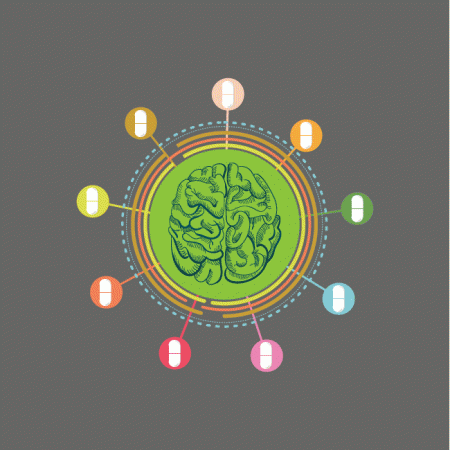Researchers propose a new approach to understanding common psychiactric treatments

(Medical Xpress)—Drugs for psychiatric disorders such as depression and schizophrenia often require weeks to take full effect. "What takes so long?" has formed one of psychiatry's most stubborn mysteries. Now a fresh look at previous research on quite a different drug—nicotine—is providing answers. The new ideas may point the way toward new generations of psychiatric drugs that work faster and better.
For several years, Henry Lester, Bren Professor of Biology at Caltech, and his colleagues have worked to understand nicotine addiction by repeatedly exposing nerve cells to the drug and studying the effects. At first glance, it's a simple story: nicotine binds to, and activates, specific nicotine receptors on the surface of nerve cells within a few seconds of being inhaled. But nicotine addiction develops over weeks or months; and so the Caltech team wanted to know what changes in the nerve cell during that time, hidden from view.
The story that developed is that nicotine infiltrates deep into the cell, entering a protein-making structure called the endoplasmic reticulum and increasing its output of the same nicotine receptors. These receptors then travel to the cell's surface. In other words, nicotine acts "inside out," directing actions that ultimately fuel and support the body's addiction to nicotine.
"That nicotine works 'inside out' was a surprise a few years ago," says Lester. "We originally thought that nicotine acted only from the outside in, and that a cascade of effects trickled down to the endoplasmic reticulum and the cell's nucleus, slowly changing their function."
In a new research review paper, published in Biological Psychiatry, Lester—along with senior research fellow Julie M. Miwa and postdoctoral scholar Rahul Srinivasan—proposes that psychiatric medications may work in the same "inside-out" fashion—and that this process explains how it takes weeks rather than hours or days for patients to feel the full effect of such drugs.
"We've known what happens within minutes and hours after a person takes Prozac, for example," explains Lester. "The drug binds to serotonin uptake proteins on the cell surface, and prevents the neurotransmitter serotonin from being reabsorbed by the cell. That's why we call Prozac a selective serotonin reuptake inhibitor, or SSRI." While the new hypothesis preserves that idea, it also presents several arguments for the idea that the drugs also enter into the bodies of the nerve cells themselves.
There, the drugs would enter the endoplasmic reticulum similarly to nicotine and then bind to the serotonin uptake proteins as they are being synthesized. The result, Lester hypothesizes, is a collection of events within neurons that his team calls "pharmacological chaperoning, matchmaking, escorting, and abduction." These actions—such as providing more stability for various proteins—could improve the function of those cells, leading to therapeutic effects in the patient. But those beneficial effects would occur only after the nerve cells have had time to make their intracellular changes and to transport those changes to the ends of axons and dendrites.
"These 'inside-out' hypotheses explain two previously mysterious actions," says Lester. "On the one hand, the ideas explain the long time required for the beneficial actions of SSRIs and antischizophrenic drugs. But on the other hand, newer, and very experimental, antidepressants act within hours. Binding within the endoplasmic reticulum of dendrites, rather than near the nucleus, might underlie those actions."
Lester and his colleagues first became interested in nicotine's effects on neural disorders because of a striking statistic: a long-term tobacco user has a roughly twofold lower chance of developing Parkinson's disease. Because there is no medical justification for using tobacco, Lester's group wanted more information about this inadvertent beneficial action of nicotine. They knew that stresses on the endoplasmic reticulum, if continued for years, could harm a cell. Earlier this year, they reported that nicotine's "inside-out" action appears to reduce endoplasmic reticulum stress, which could prevent or forestall the onset of Parkinson's disease.
Lester hopes to test the details of "inside-out" hypotheses for psychiatric medication. First steps would include investigating the extent to which psychiatric drugs enter cells and bind to their nascent receptors in the endoplasmic reticulum. The major challenge is to discover which other proteins and genes, in addition to the targets, participate in "matchmaking, escorting, and abduction."
"Present-day psychiatric drugs have a lot of room for improvement," says Lester. "Systematic research to produce better psychiatric drugs has been hampered by our ignorance of how they work. If the hypotheses are proven and the intermediate steps clarified, it may become possible to generate better medications."















